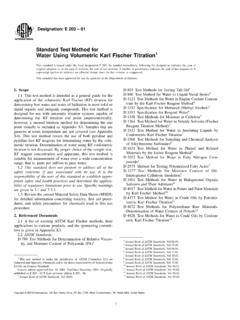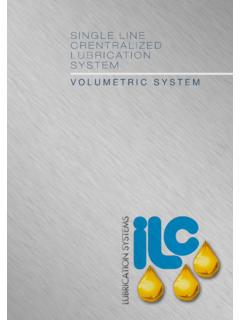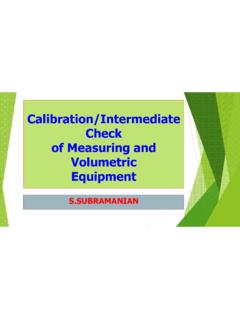Transcription of Standard Practice for Calibration of Laboratory Volumetric ...
1 Designation: E 542 01 Standard Practice forCalibration of Laboratory Volumetric Apparatus1 This Standard is issued under the fixed designation E 542; the number immediately following the designation indicates the year oforiginal adoption or, in the case of revision, the year of last revision. A number in parentheses indicates the year of last reapproval. Asuperscript epsilon (e) indicates an editorial change since the last revision or Standard has been approved for use by agencies of the Department of This Practice covers procedures for use in the calibrationof Volumetric ware, in accordance with Specification E694such as is in common use in chemical and clinical is based on the gravimetric determination of the quantity ofwater either contained or delivered, and the conversion of thisvalue to true volume at the Standard temperature of 20 C bymeans of suitable equations and Standard tables.
2 Calibrationusing mercury is excluded. Calibration may be performedusing alternative gravimetric methodology, provided that it isdemonstrated and documented that the results obtained areequivalent to those obtained using the methodology This Practice is intended to encompass capacity warebetween the limits of cm3and 2000 cm3. Typical productsfalling within the purview of this Practice are burets graduated to deliver , graduated cylinders, Volumetric flasks, specificgravity flasks, measuring and dilution pipets, and transfer andcapacity The procedures are not recommended for Calibration ofapparatus with capacities below cm3, such as Standard does not purport to address all of thesafety concerns, if any, associated with its use.
3 It is theresponsibility of the user of this Standard to establish appro-priate safety and health practices and determine the applica-bility of regulatory limitations prior to Referenced Standards:E 1 Specification for ASTM Thermometers2E 694 Specification for Volumetric Ware3SI 10 Standard for Use of the International System of Units(SI) (the Modernized Metric System)33. Summary of This Practice is based upon a determination of thevolume of water either contained in or delivered by the are given for cleaning, setting the meniscus,manipulating the apparatus, weighing, and converting theweight to the appropriate Standard Significance and The primary purpose of this Practice is to provideuniform procedures that may be used to accurately calibrate awide variety of Volumetric ware.
4 The techniques are simple inconcept and can provide reliable results, provided the proce-dures are followed faithfully. Accordingly, the Practice shouldprovide a means for checking the original Calibration ofglassware and similar apparatus and for periodic rechecks asthe need should Borosilicate Volumetric glassware will hold its calibra-tion indefinitely provided that it is not exposed to hydrofluoricacid, hot phosphoric acid, or strong, hot alkalis, and that it isnot heated above 150 C when dry. A frosting of the glasssurface (viewed when dry) indicates that chemical attack hasoccured, and recalibration may be in order. As a precaution,however, it is recommended that the glassware be recalibratedafter ten years of service regardless of its Soda-lime Volumetric glassware will become frostedwith time because of attack from moisture in the atmosphere aswell as from the chemicals mentioned above.
5 In addition, itshould not be heated above 90 C when dry. It is recommended,therefore, that it be recalibrated after five years of serviceunless frosting (viewed when dry) is observed Units of The basic SI unit for volume is the cubicmetre, m3. Due to its large size, it is rarely used in volumetriccalibration. Rather, the cubic centimetre, cm3, is used and willbe employed in this Practice . The unit, millilitre, mL, may beconsidered as equivalent to the cubic Temperature Volumetric ware is almost uni-versally calibrated at 20 C. The procedures described providefor such a Calibration . When it is necessary to work at higherambient temperatures, such as is the case in tropical countries, Calibration may be required at the International StandardsOrganization (ISO) recommended temperature of 27 C.
6 Equa-tions are given to correct the calibrated volume to othertemperatures as this may be required or Practice is under the jurisdiction of ASTM Committee E41 on LaboratoryApparatus, and is the direct responsibility of Subcommittee on edition approved Octo. 10, 2001. Published January 2002. Originallypublished as E 542 79. Last previous edition E 542 Book of ASTM Standards, Vol Book of ASTM Standards, Vol ASTM International, 100 Barr Harbor Drive, PO Box C700, West Conshohocken, PA 19428-2959, United , having sufficient capacity to weigh the loadedvessel. The sensitivity of the balance will be a limiting factorin the accuracy of the measurements. Either a single-pan,direct-reading balance or an equal-arm balance of adequatesensitivity and capacity may be used.
7 In either case the weightsmust be calibrated with adequate accuracy. Ordinarily, weightswith NBS Class S-1 tolerances are required. The balance musthave physical dimensions to accept the size of the vesselswhich need to be , for measuring the temperature of thewater. The accuracy of this Calibration will depend upon theaccuracy requirement of the Volumetric Calibration (see Section14 for tolerances). , capable of providing atmospheric pressuremeasurements, consistent with the tolerances given in Section14. Alternatively, the existing barometric pressure may beobtained from the local weather or Deionized Water, suitable for general labo-ratory General This section describes manipulative techniques requiredto obtain accurate and reproducible Volumetric It is important that Volumetric ware be thoroughlycleaned before being tested or used.
8 Glass apparatus must besufficiently clean to permit uniform wetting of the clean, the walls will be uniformly wetted and the waterwill adhere to the glass surface in a continuous film. The cleanwalls of some plastic apparatus, however, will not be wetted.(Follow the instructions of the manufacturer. Do not usematerials which will attack, discolor, or swell the plasticware.)Lack of cleanliness causes irregularities in capacity by distort-ing the water surface. The liquids usually used for cleaningglassware are sodium dichromatic-sulfuric acid cleaning solu-tion (commercially available from Laboratory supply houses),nitric acid, fuming sulfuric acid, alcohol, and water. The choiceof cleaning agent to be used depends on the nature of thecontaminant.
9 After cleaning with the cleaning solution andthoroughly rinsing with tap water, the vessel should be rinsedwith distilled After cleaning, the vessel should be rinsed with ethylalcohol and dried with clean air at room temperature. It is notnecessary to dry any vessel marked to deliver. Whencleaning small articles such as pipets, it is usually easier to fillthem with cleaning solution by suction, using a vacuum line, ifavailable, or a small rubber bulb, but never by mouth. Thesolution should be drawn through the pipet several times untilthe entire inside surface is evenly coated. Rinse thoroughlywith tap water and then with distilled water. For cleaningflasks, pour in enough cleaning solution while rotating so thata film of solution will cover the entire interior surface.
10 A breakin the film indicates a contaminated area. For filling a buretwith cleaning solution, it should be held in a vertical positionand filled by pouring into the top. Open the stopcock to of the type of vessel, always rinse thoroughly, firstwith tap water and then with distilled water. Plastic volumetricware should be cleaned in an appropriate manner and Setting a Liquid the Meniscus For all apparatus calibratedby this procedure, the reading is made on the lowest point ofthe meniscus. In order that the lowest point may be observed,it is necessary to place a shade of some dark materialimmediately below and behind the meniscus, which renders theprofile of the meniscus dark and clearly visible against a lightbackground. A convenient device for this purpose is a collar-shaped section of thick black rubber tubing, cut open at oneside and of such size as to clasp the tube firmly.








